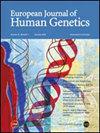elmo2相关骨内血管畸形:新发病变异、临床随访及治疗方法
IF 3.7
2区 生物学
Q2 BIOCHEMISTRY & MOLECULAR BIOLOGY
引用次数: 0
摘要
原发性骨内血管畸形(VMPI, #606893)是一种极其罕见的疾病,由ELMO2的双等位基因致病变异引起。迄今为止,只有6个具有致病性ELMO2变异的家族被描述为导致VMPI表型。VMPI的特点是血管畸形压迫面部骨骼,经常导致危及生命的并发症,如大出血和颅内疝。在VMPI中,血管畸形是进行性的,没有因果治疗。我们报道了四个未报道的典型VMPI个体,其中包含ELMO2双等位基因截断变异,包括一个新的纯合子25 bp重复c.579_603dup;p.(Leu202Profs*47),全外显子组测序检测。我们提供广泛的临床随访数据,包括从产前诊断起对个体的密切监测。利用计算机断层扫描或磁共振成像血管造影,我们描述了受影响个体中具有快速血流特性的血管畸形的放射学特征。此外,我们对来自一个个体的样本进行了全面的组织病理学评估。该分析不仅揭示了先前描述的相似形态学特征,而且还发现了一些非典型的发现,例如新生骨形成增加。此外,我们首次报道了心得安和西罗莫司在VMPI中的应用。虽然我们注意到一个个体出血事件的减少,但在其他接受西罗莫司治疗的个体中,总体上没有观察到显著的临床改善。此外,西罗莫司在两例患者中导致严重的感染并发症和脓肿形成。相反,心得安的耐受性相对较好,尽管它没有导致任何显著的临床结果。随访期间,1例患者因严重出血死亡。本文章由计算机程序翻译,如有差异,请以英文原文为准。

ELMO2-related intraosseous vascular malformation: new cases with novel pathogenic variants, clinical follow-up and therapeutic approaches
Primary intraosseous vascular malformation (VMPI, #606893) is an ultra-rare disorder caused by biallelic pathogenic variants in ELMO2. To date, only six families with pathogenic ELMO2 variants causing a VMPI phenotype have been described. VMPI is characterized by vascular malformations that compress the facial bones, often leading to life-threatening complications, such as massive bleeding and intracranial herniation. In VMPI, vascular malformations are progressive and there is no causal therapy available. We report on four unreported individuals with classical VMPI harbouring biallelic truncating variants in ELMO2, including a novel homozygous 25 bp duplication c.579_603dup; p.(Leu202Profs*47), detected by whole-exome sequencing. We present extensive clinical follow-up data, including a close monitoring of an individual from prenatal diagnosis onwards. Using computed tomography or magnetic resonance imaging angiography, we described the radiological characteristics of vascular malformations with fast-flow properties in the affected individuals. Additionally, we conducted a comprehensive histopathological evaluation of samples from one individual. This analysis revealed not only the similar morphological features described previously but also some atypical findings, such as increased de novo bone formation. Furthermore, we report for the first time the use of propranolol and sirolimus in VMPI. While we noted a reduction of bleeding episodes in one individual, no significant clinical improvement was observed overall in the other individuals treated with sirolimus. Moreover, sirolimus led to severe infectious complications with abscess formation in two individuals. Conversely, propranolol was relatively well tolerated, although it did not result in any notable clinical outcomes. During follow-up, one individual died due to severe bleeding.
求助全文
通过发布文献求助,成功后即可免费获取论文全文。
去求助
来源期刊

European Journal of Human Genetics
生物-生化与分子生物学
CiteScore
9.90
自引率
5.80%
发文量
216
审稿时长
2 months
期刊介绍:
The European Journal of Human Genetics is the official journal of the European Society of Human Genetics, publishing high-quality, original research papers, short reports and reviews in the rapidly expanding field of human genetics and genomics. It covers molecular, clinical and cytogenetics, interfacing between advanced biomedical research and the clinician, and bridging the great diversity of facilities, resources and viewpoints in the genetics community.
Key areas include:
-Monogenic and multifactorial disorders
-Development and malformation
-Hereditary cancer
-Medical Genomics
-Gene mapping and functional studies
-Genotype-phenotype correlations
-Genetic variation and genome diversity
-Statistical and computational genetics
-Bioinformatics
-Advances in diagnostics
-Therapy and prevention
-Animal models
-Genetic services
-Community genetics
 求助内容:
求助内容: 应助结果提醒方式:
应助结果提醒方式:


